Apple Posts Record-Breaking Q1 2022 Despite Supply Constraints
As the world wheezes its way into the third year of the global pandemic, Apple has remained healthy. Reporting on its fiscal Q1 2022 financial results, Apple announced profits of $34.6 billion ($2.10 per diluted share) on record-breaking revenues of $123.9 billion. The company’s revenues were up 11% compared to the year-ago quarter, with profits up over 20% (see “Apple Weathers the Storm to Shatter Records in Q1 2021,” 27 January 2021).
Not all was sunshine and rainbows: iPad sales revenues were down 14.1% from last year’s results, and revenues in Japan also fell by 14.2% compared to last year. Nonetheless, revenues from every other geographic segment rose, and Apple posted all-time revenue records for its iPhone, Mac, Wearables, and Services categories. Here’s how things broke down by category.
As to why iPad sales slumped compared to Apple’s otherwise stellar results, the company repeatedly blamed supply constraints in “legacy nodes,” whatever those are. Apple CEO Tim Cook noted that the problem was not largely due to shared components with other devices—Apple wasn’t prioritizing iPhones over iPads—but he didn’t elaborate. In any case, Apple expects that supply constraints should ease somewhat in the current quarter.
Otherwise, Apple’s sales were tremendous. iPhone revenue was up 9.2% year-over-year, raking in $71.6 billion. Single-digit growth is fairly low for the iPhone, but Apple barely missed double-digits. Cook and CFO Luca Maestri blamed supply chain issues for the iPhone revenues not being higher, with Cook noting that demand for iPhones was very strong.
The Mac saw an astonishing 25.1% increase in revenue growth—apparently, it’s less susceptible to those nasty legacy node supply constraints—topping off what Apple called the Mac’s six best quarters ever. In fact, this quarter was the first ever in which Mac sales exceeded $10 billion. Cook attributed much of this success to the new M1-based Macs.
Apple’s Services sector continues to be one of the fastest-growing, seeing a 23.8% revenue increase year over year and bringing in $19.5 billion. Active subscriptions (which provide a steady revenue stream) reached 785 million.
Apple likewise saw strong growth in Wearables, with a 13.3% increase over the year-ago quarter. Apple said that two-thirds of Apple Watch purchasers last quarter were new to the Apple Watch.
Aside from the revenue decline in Japan, which was likely due to the Japanese economy struggling throughout 2021, Apple continued to see growth in every other geographical segment. Greater China, in particular, brought in 21% more revenue than it did last year. Cook noted that the percentage of switchers to iPhone in Greater China had reached double-digits even in the face of a strong market for domestic devices.
Overall, Q1 2022 was yet another incredibly strong quarter for Apple, and it’s particularly gratifying to see the Mac on such a prolonged upswing. That’s a testament to the attractiveness of M1-based Macs, and with professional-level desktop models like the iMac and Mac Pro hopefully making the jump to Apple silicon this year, Mac revenues should remain strong. Supply constraints are clearly Apple’s top concern, but the fact that all product categories other than iPad managed significant growth despite shortages suggests that the company is largely doing a good job of managing those constraints.
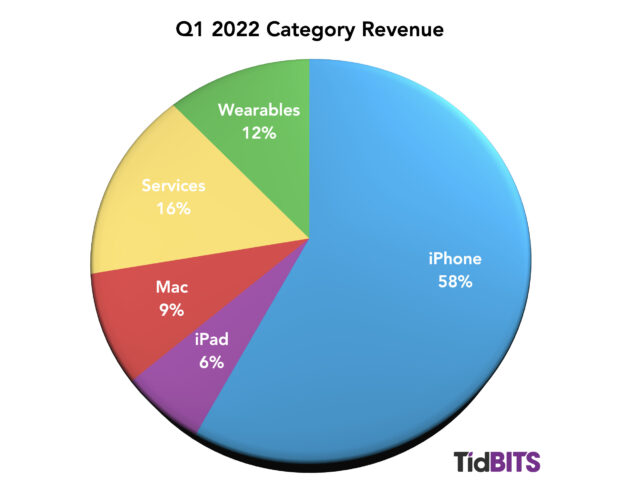
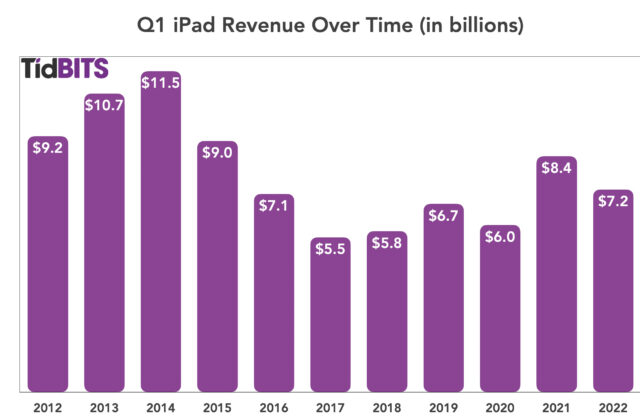
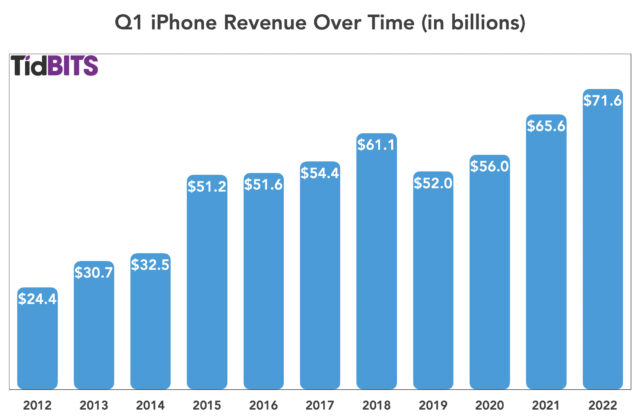
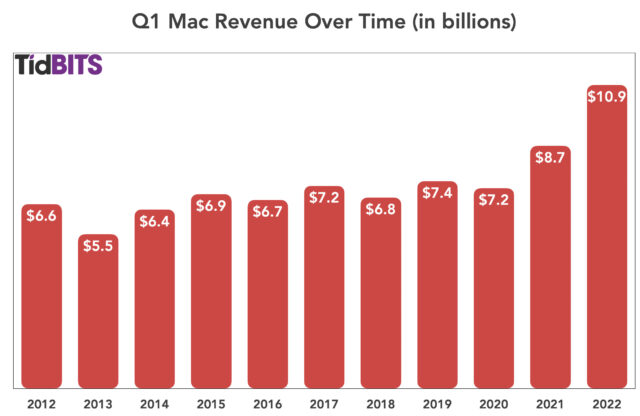
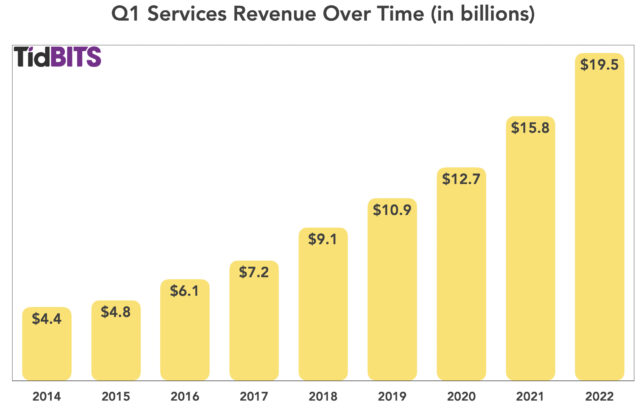
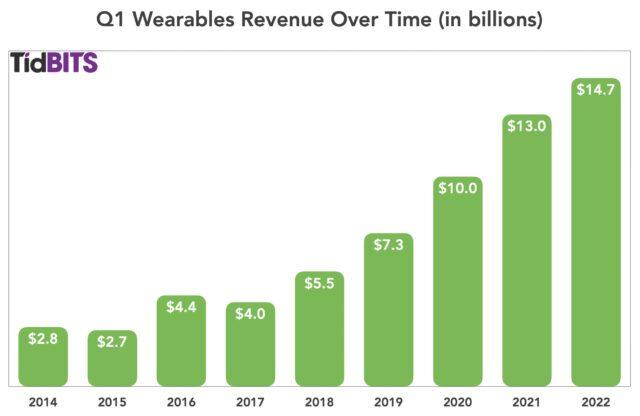
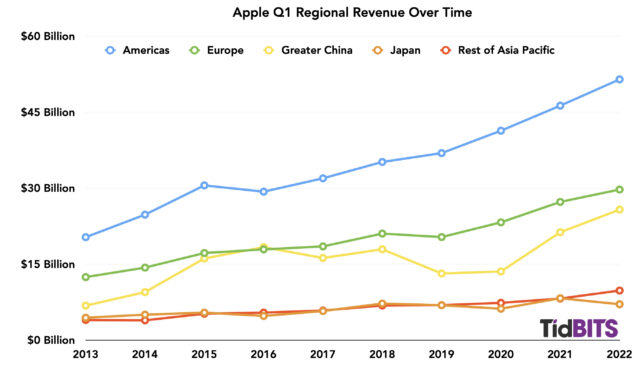
I thought it was pretty clear that Apple diverted supplies from iPad production to iPhone production. Now what chip(s) that could be, I don’t know.
No other category showed as much growth as the Mac. M1 has been a tremendous success. And growth would likely have been even higher if Apple had been able to keep up with 14"/16" MBP demand. Go Mac!
We originally stated that the iPad downturn was unexplained and it wasn’t discussed during the call. Upon reading the Six Colors transcript, we realized those things weren’t true. Apple blamed the iPad downturn on supply chain issues, and we’ve corrected the article accordingly.
For some time now I have suspected that iPhone would be the bait that would entice people to leap into Apple’s ecosystem. It’s great to see that the whole spectrum is thriving and continuing to expand.
The iPad sale would have been better if Apple started selling iPads with more ports. Audio i-o minijack, at least one Thundertbolt 4 - in addition to the Lightening port.
Not sure what purpose that would serve. Do many iPad users need access to external storage at >10 Gbps ?
Correct me if I’m wrong, but wouldn’t more ports make an iPad heavier and bulkier?
I really miss the audio jack when using the Korg music apps. Bluethooth audio is lagging without it or it moves out of sync. And I could need an external drive for video and photo. It is possible to do some of this with a dongle, but that does not apply to music making.
Guess we wil have the answer to that when we see the new Macbook Air later this year. If the Macbook has the same CPU as the iPad, then why can it not have the same ports?
The present USB-C port should be able to take care of that. Sounds like perhaps instead of a specific dongle, you should be looking at a proper USB-C hub.
I’m not surprised that the M1 Macs have been so successful. I have a 27inch iMac with the 8 core i7 which is about 18 months old and would have been 2nd fastest at the time, and a MacBook Air with the cheapest option and it outperforms the iMac using the R statistical language. I would have waited for the ARM iMac but I need to run a Windows program.
It could have as many ports as Apple could manage to squeeze in, if they wanted to. But heavy and bulky iPad models are likely to be a mega commercial disaster. Sleek, slim, sexy and speedy are major selling points for Apple products. And it seems like wireless connectivity had been a popular feature for decades. IIRC, Dell and other PC and Android manufacturers have been reducing the number of ports in their devices as well.
Remember back about 20 years ago when Steve Jobs unveiled WiFi? What a revelation it was!
Anyone who wants more ports can buy a dongle or a hub.
Take a look at Facebook’s quarterly results, and in particular, upon whom they are blaming their drastic and consistent drop in revenue and audience size:
Of course they will never consider that their financial problems are the result of over 10 years of policies that an ever-increasing percentage of their users consider abusive.
I shut down my Facebook and Twitter accounts in 2013 because their policies at the time ticked me off. They’re several orders of magnitude more abusive today then they were then. So it comes as no surprise that their customers are looking for and leaving for alternative platforms.
But sure go ahead and blame Apple. That’s a sure-fire way to return to record profits.
I think that this might be why Zuckerberg is rebranding the Facebook conglomerate into Meta; what I find particularly aggravating is they are not addressing any of the privacy and security issues any, or all, of their properties have. And will the new headset stuff they are promoting be any different privacy and security wise? IMHO, it will probably just as creepy, and probably even more so. In this case, “a rose by any other name” will probably not even smell as sweet.